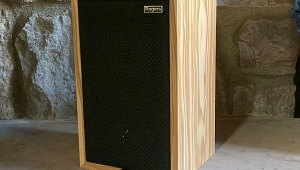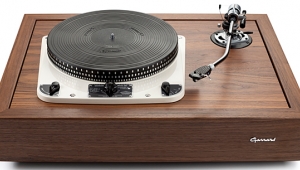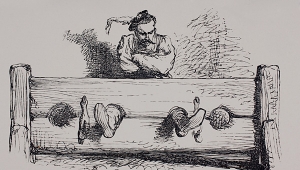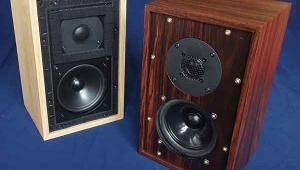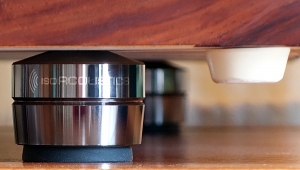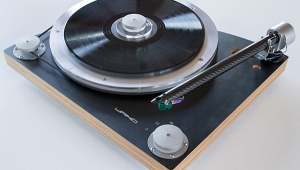| Columns Retired Columns & Blogs |
Listening #67 Follow-Up, July 2015
Updating an update
Remarkably, it has been 10 years since the German manufacturer EMT reissued their classic 997 "banana" tonearm of the 1970s. And now, in the same manner that Darryl Jones has been the Rolling Stones' bassist for almost as long as Bill Wyman held the job—a mind-blowing fact if ever there was one—the day draws near when the EMT 997 reissue will have been on the market longer than the original was. Where has the time gone?
The 997 tonearm was introduced in 1974 as a companion for the then-well-established EMT 927 broadcast turntable, whose bigger-than-average (17") platter requires the use of a longer-than-average tonearm. Until that time, most 927s were bundled with Ortofon's RF-297 arm, which has a spindle-to-pivot distance of 297mm; the new EMT 997 was of similar length but slightly different geometry—a key to which is the armtube's position alongside, rather than coincident with, the pivot center—and it offered a spring-actuated dynamic tracking-force mechanism that was reliably well calibrated. EMT, of course, might add that the 997 was a better-made product, with better wiring, higher-quality bearings, and slightly lower effective mass than earlier transcription-length arms—qualities that, in years to come, would endear the 997 to domestic-audio enthusiasts with a taste for vintage gear.
Early in this century, Keith Aschenbrenner, of the design and distribution firm Auditorium 23, began to gather support for returning the 997 tonearm to production. He won approval from the newly streamlined EMT corporation—now situated in Mahlberg, Germany—and coordinated the efforts to locate the original production tools and dies, and to coax from retirement EMT's Rudi Glaser, whose help was needed in training new tonearm builders. The goal was to make the current-generation EMT 997 exactly like the original in every way, and Aschenbrenner and EMT succeeded to an extent that eludes most people who are called to the profession of reissuing vintage gear; the only thing different about the new EMT 997 tonearm ($5250) is its availability with the nearly universal SME (or international) configuration of headshell contact pins, alongside the version that's configured for use only with vintage EMT pickups.
For a $5000-plus tonearm whose appeal is limited mostly to vintage-audio enthusiasts, the new 997 appears to have sold well (I bought mine in 2008). But in time, the people who revived the EMT began to consider improving it—a scary word to anyone, myself included, who cringes to see the best of the old painted over with the most banal of the new. In domestic audio, that usually means designer capacitors, designer resistors, MDF instead of plywood, silver-plated wire, enormous, jewelry-like connectors, and lots and lots of silicon.
I needn't have worried. According to Jonathan Halpern of Tone Imports, which distributes EMT products in the US and Canada (footnote 2), current production of the 997 reflects two major improvements, one cosmetic, the other structural. With regard to the former, it turns out that, on the armtubes of early reissue samples, the paint was visibly stressed at the points where the tube had been bent into shape. Current samples are said to be formed and finished more carefully. The second, structural refinement pertains to the straight-sided, bell-shaped housing that covers and supports the arm's downforce mechanism and vertical bearings. In original EMT 997s and early reissue samples, that part was stamped out of aluminum alloy. But because the vertical bearings are tensioned against this part—which also holds in place one end of the downforce spring—the benefits of a stronger material and a more precise fit are apparent. Thus, on current-production arms, the stamped-alloy housing is replaced by one CNC-machined from brass.
Last year, I received from Tone Imports a new sample of the EMT 997 that incorporated both refinements. My 2008 sample must have been free from the bending and finishing flaws described by Halpern—it and the new one looked equally fine to me. (Not that I'm a terribly good judge. Some people have tin ears; I have a tin eye.) As for the change from stamped alloy to machined brass for the bearing housing—which was visibly apparent only after it had been pointed out to me—there was no doubt that the bearings on the new sample were even better adjusted than those on the one I'd bought: The vertical bearings on the newest 997 had less play—in fact, none that I could detect—with no signs of added friction. If anything, the newest arm, when set for zero downforce and perfect balance, was even quicker in returning to its resting position after deflection. And after several months of harder-than-average use—as a reviewer, I change pickup heads and counterweights far more often than would the average 997 owner—the bearings remain in perfect condition.
The sonic consequences appeared to be a surprising if subtle increase in musical drive—surprising because the 997 reissue was already so good in that respect. Yet when I used the newest sample of the EMT arm to play some of my favorite records by Dexter Gordon, David Grisman, and Bill Monroe—or some beloved 78s by Louis Armstrong, Django Reinhardt, and Red Allen (footnote 1)—it was easier than ever to interpret what I was hearing not as mere sound but as music, being made on the spot by people who leaned in to every note. It also seemed that the improvement in the 997's bearing housing resulted in a slight increase in the sense of scale; listening to the 1962 recording by Hans Knappertsbusch and the Bayreuth Festival Orchestra and Chorus of Wagner's Parsifal (Philips PHS 5-950, footnote 2), the space in which the Prelude to Act I unfolded seemed more expansive, adding to the feelings of serenity and consecration that attend that music under the best of conditions.
Note that those observations are based on a sample of the EMT that has been painstakingly set up and adjusted. In a nutshell, and setting aside such considerations as sensible design and high-quality construction, there are two primary reasons for having a transcription-length tonearm such as the 997: Its higher-than-usual mass is more attuned to the low-compliance pickups favored by some hobbyists, myself included, and its greater-than-average length serves to minimize the effect on lateral tracking performance of the curve of the arc through which any pivoted arm must pass. But the latter comes with a caveat: Because a longer arm creates a straighter arc, it requires considerably smaller amounts of overhang and offset angle—the two elements introduced to the geometry of pickup arms in order to make their behavior more ideal. Yet as overhang and offset are reduced, errors made in achieving them become far more critical—and so, in a real sense, while the extra-long arm has the potential for less lateral-tracking-error distortion, it also carries the potential for greater distortion if not installed and adjusted correctly. (There are parallels in other areas of phonography, not least being the design and manufacture of turntable bearings: The larger the bearing, the easier it is to keep runout error to a minimum, relative to the bearing's diameter. Those who are impressed with claims that bigger is better may benefit from an added measure of cynicism.)
Now as always, tonearm shoppers are encouraged to read and commit to memory "Arc Angles," Keith Howard's landmark article on tonearm geometry. My own EMT 997 installation is based on Howard's observations, and I'll add to the online version of this column the precise spindle-to-pivot distance and other parameters I've arrived at and put into use.
In the months after I received my first EMT 997 reissue, its superiority to every other tonearm I'd used became obvious. That impression hasn't lost a bit of its strength—even in the face of a growing number of new and often excellent-quality transcription-length arms—and the arrival of an even better-sounding 997 leaves me no choice but to reconsider its listing among Stereophile's "Recommended Components," and to suggest the seldom-used Class A+: The EMT remains the best-sounding tonearm I have used on my vintage Garrard 301 and Thorens TD 124 turntables, and the best-built arm I have owned.—Art Dudley
Footnote 1: The jazz Red Allen, not the bluegrass Red Allen (whom I also like).
Footnote 2: Recently made available as a Speakers Corner reissue that I have yet to hear.
- Log in or register to post comments


